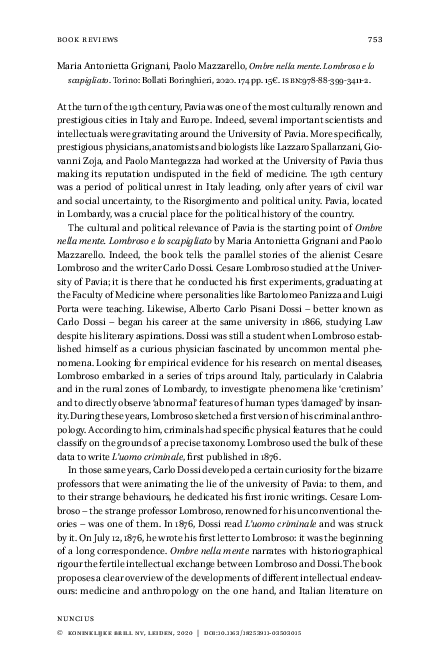Academia.edu no longer supports Internet Explorer.
To browse Academia.edu and the wider internet faster and more securely, please take a few seconds to upgrade your browser.
Fabio Lusito. Book review of "Ombre nella mente. Lombroso e lo scapigliato" Bollati Boringhieri, 2020. In Nuncius 35, pp. 753-755 (2020)
Fabio Lusito. Book review of "Ombre nella mente. Lombroso e lo scapigliato" Bollati Boringhieri, 2020. In Nuncius 35, pp. 753-755 (2020)
2020, article
Book review of "Ombre nella mente. Lombroso e lo scapigliato" Bollati Boringhieri, 2020
Related Papers
2021 •
Il pensiero umanistico ha attribuito all’indagine antropologica un ruolo centrale nella riscoperta dei classici. L’esaltazione della dignitas hominis, coniugata con il tema ascetico del contemptus mundi, contribuisce alla formazione di un’immagine complessa dell’uomo, la cui cifra distintiva è uno stato di inquietudine. Le opere di Marsilio Ficino offrono un apporto prezioso ed efficace a questo dibattito: dalle opere maggiori ai commenti ai dialoghi di Platone, il filosofo fiorentino presenta l’essere umano sempre sospeso tra la miseria come condizione contingente e la deificatio come più alta aspirazione da compiere in vita attraverso la riscoperta del sé. Questo volume analizza i concetti di ‘miseria’ e ‘dignità’ dell’uomo come chiave interpretativa del pensiero ficiniano, restituendone l’originalità derivante dall’incontro tra numerose fonti eterogenee e la geniale attività speculativa di Ficino. Il raggiungimento di una conoscenza basata non soltanto sulla discorsività del processo dianoetico, ma anche sulla capacità intuitiva della mens, è il compito che ogni uomo deve svolgere al fine di perfezionare la sua natura, lungo un itinerario impervio segnato da quelle luci ed ombre che saranno ereditate dal Rinascimento maturo. Humanism assigns a central role to anthropological investigation in the rediscovery of classical texts. The emphasis on dignitas hominis, together with the ascetic issue of contemptus mundi, contributes to develop a complex picture of man, whose distinctive feature is restlessness. Marsilio Ficino’s works offer a valuable and effective contribution to this debate: since his main works to the later commentaries on Plato’s dialogues, the Florentine philosopher presents the human being always suspended between miseria, intended as a contingent condition, and deificatio, that is the highest aspiration to be reached in life through the rediscovering of the self. This volume analyzes the concepts of ‘misery’ and ‘dignity’ of man as interpretative keys for Ficinian thought, by restoring its originality as a result of the encounter between many heterogeneous sources and Ficino’s ingenious speculative activity. The achievement of a knowledge based not only on the discursiveness of the dianoetic process, but also on the intuitive capacity of the mind, is the task that each man must accomplish in order to make his nature perfect, along an impervious path, marked by those lights and shadows which will be inherited by the full-fledged Renaissance.
2006 •
2019 •
Titolo del volume: Filosofia nel XII secolo / Philosophy in the 12th century. Studi raccolti in memoria di Riccardo Quinto, a cura di / edited by Magdalena Bieniak, Caterina Tarlazzi. Articoli di: Christophe Erismann, Alisa Kunitz-Dick, Wojciech Wciórka, Luisa Valente, Mark J. Clark, Massimiliano d'Alessandro, Magdalena Bieniak, Marcin Trepczyński, Gregorio Piaia.
2015 •
2023 •
RELATED PAPERS
2017 •
Journal of Strength and Conditioning Research
Effect of Resistance Training Frequency on Neuromuscular Performance and Muscle Morphology After 8 Weeks in Trained Men2018 •
BAWAL Widya Riset Perikanan Tangkap
ASPEK BIOLOGI DAN DINAMIKA POPULASI IKAN LAYANG BIRU (Decapterus macarellus Cuvier, 1833) DI PERAIRAN LAUT SULAWESI2019 •
Call Girls in Gokulpuri
FULL ENJOY — 9953040155 Call Girls in Gokulpuri | Delhi2025 •
2015 •
"Rem Koolhaas nas Metrópoles Delirantes: Entre a Bigness e o Big Business"
Apresentação do livro "Rem Koolhaas nas Metrópoles Delirantes: Entre a Bigness e o Big Business" de Paolo Colosso (20172017 •
Innovations in Systems and Software Engineering
From Statecharts to Verilog: a formal approach to hardware/software co-specification2006 •
Learning and Individual Differences
The relation between academic abilities and performance in realistic word problems2020 •
Quarterly Journal of Training and Development of Human Resources
Designing and explaining the professional development model of senior managers of Iran's telecommunications industry Case study: companies MCI, Irancell, Rightel2020 •
MİLLÎ MÜCADELE’NİN YEREL TARİHİ 1918-1923 Adana - Kahramanmaraş - Şanlıurfa - Kilis Gaziantep - Hatay - Mersin - Osmaniye
Urfa'nın İşgali ve Kurtuluşu2023 •

 paolo mazzarello
paolo mazzarello